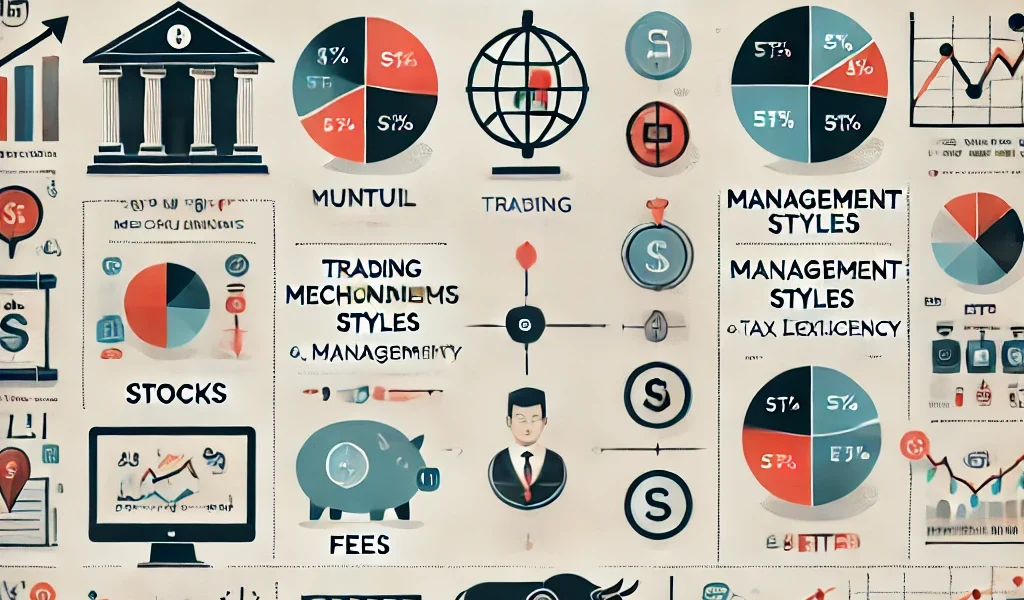Investors often find themselves choosing between mutual funds and exchange-traded funds (ETFs) when building their portfolios. While both investment vehicles pool money from multiple investors to buy diversified assets, their structures, costs, and trading mechanisms differ significantly. Understanding these differences can help you align your investment strategy with your financial goals.
In this guide, we will compare mutual funds and ETFs, explore their pros and cons, and provide insights on how to decide which one suits your investment style best.
1. Understanding Mutual Funds and ETFs
What is a Mutual Fund?
A mutual fund is a professionally managed investment vehicle that pools money from multiple investors to invest in a diversified portfolio of stocks, bonds, or other assets. Mutual funds are actively or passively managed and are priced once a day at the Net Asset Value (NAV).
Types of Mutual Funds:
- Equity Funds – Invest primarily in stocks.
- Debt Funds – Invest in fixed-income securities like bonds.
- Hybrid Funds – Invest in a mix of equities and bonds.
- Index Funds – Passively track a specific market index.
What is an ETF?
An exchange-traded fund (ETF) is also a pooled investment vehicle but trades on stock exchanges like individual stocks. Most ETFs are passively managed and track an index, although actively managed ETFs exist. Unlike mutual funds, ETFs can be bought and sold throughout the trading day.
Types of ETFs:
- Stock ETFs – Track equity indices like the S&P 500.
- Bond ETFs – Invest in fixed-income securities.
- Sector ETFs – Focus on specific industries like technology or healthcare.
- Commodity ETFs – Invest in commodities like gold or oil.
2. Key Differences Between Mutual Funds and ETFs
| Feature | Mutual Funds | ETFs |
|---|---|---|
| Trading | Bought/sold at NAV at the end of the day | Traded throughout the day like stocks |
| Management Style | Mostly actively managed, some passive | Mostly passively managed, some active |
| Expense Ratio | Generally higher due to active management | Lower expense ratios for passive ETFs |
| Minimum Investment | Usually has a minimum investment requirement | No minimum investment, just price per share |
| Tax Efficiency | Less tax-efficient due to frequent portfolio turnover | More tax-efficient due to lower turnover |
| Liquidity | Less liquid; orders processed once per day | Highly liquid; can be traded anytime during market hours |
3. Pros and Cons of Mutual Funds and ETFs
✅ Advantages of Mutual Funds
✔ Professional Management – Fund managers make investment decisions on behalf of investors.
✔ Diversification – Provides exposure to multiple securities, reducing risk.
✔ Systematic Investment Plan (SIP) – Allows regular investments with smaller amounts.
❌ Disadvantages of Mutual Funds
✘ Higher Fees – Actively managed funds have higher expense ratios.
✘ Less Liquidity – Can only be bought or sold at the end of the day.
✘ Tax Inefficiency – Investors may face capital gains taxes due to frequent portfolio turnover.
✅ Advantages of ETFs
✔ Lower Expense Ratios – Most ETFs have lower fees than actively managed mutual funds.
✔ Higher Liquidity – Can be bought and sold throughout the trading day.
✔ Tax Efficiency – Less capital gains tax due to the “in-kind” creation and redemption process.
❌ Disadvantages of ETFs
✘ Transaction Costs – Brokerage fees may apply for frequent buying and selling.
✘ No SIP Option – Unlike mutual funds, ETFs do not offer SIP investment plans.
✘ Passive Management Risks – Most ETFs track indices and do not outperform the market.
4. Investment Strategies: When to Choose Mutual Funds or ETFs?
When to Choose Mutual Funds
- If you prefer professional management and don’t want to monitor investments frequently.
- If you want to invest in an actively managed fund that may outperform the market.
- If you prefer investing through SIP instead of lump sums.
When to Choose ETFs
- If you want lower costs and expense ratios.
- If you need the ability to trade intraday and have high liquidity.
- If you prefer passive investing with broad market exposure.
5. Mutual Funds vs. ETFs: Which One is Better for You?
The choice between mutual funds and ETFs depends on your investment goals, risk tolerance, and preferences.
- For long-term investors who want active management and SIP flexibility, mutual funds are a better option.
- For cost-conscious investors who prefer passive index tracking and trading flexibility, ETFs are ideal.
Final Thoughts
Both mutual funds and ETFs offer unique advantages. If you prefer convenience and professional management, go for mutual funds. If you value lower costs and trading flexibility, ETFs are a better fit. The best approach is to assess your financial goals and risk tolerance before making a decision.
Would you like personalized investment recommendations based on your risk appetite and time horizon? Let me know!




